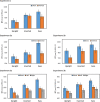How ubiquitous is the direct-gaze advantage? Evidence for an averted-gaze advantage in a gaze-discrimination task
- PMID: 33135097
- PMCID: PMC7875945
- DOI: 10.3758/s13414-020-02147-3
How ubiquitous is the direct-gaze advantage? Evidence for an averted-gaze advantage in a gaze-discrimination task
Abstract
Human eye gaze conveys an enormous amount of socially relevant information, and the rapid assessment of gaze direction is of particular relevance in order to adapt behavior accordingly. Specifically, previous research demonstrated evidence for an advantage of processing direct (vs. averted) gaze. The present study examined discrimination performance for gaze direction (direct vs. averted) under controlled presentation conditions: Using a backward-masking gaze-discrimination task, photographs of faces with direct and averted gaze were briefly presented, followed by a mask stimulus. Additionally, effects of facial context on gaze discrimination were assessed by either presenting gaze direction in isolation (i.e., by only showing the eye region) or in the context of an upright or inverted face. Across three experiments, we consistently observed a facial context effect with highest discrimination performance for faces presented in upright position, lower performance for inverted faces, and lowest performance for eyes presented in isolation. Additionally, averted gaze was generally responded to faster and with higher accuracy than direct gaze, indicating an averted-gaze advantage. Overall, the results suggest that direct gaze is not generally associated with processing advantages, thereby highlighting the important role of presentation conditions and task demands in gaze perception.
Keywords: Averted gaze; Direct gaze; Gaze discrimination; Gaze processing; Social cognition.
Conflict of interest statement
The authors declare that there are no conflicts of interest.
Figures




Similar articles
-
Talking heads or talking eyes? Effects of head orientation and sudden onset gaze cues on attention capture.Atten Percept Psychophys. 2018 Jan;80(1):1-6. doi: 10.3758/s13414-017-1462-y. Atten Percept Psychophys. 2018. PMID: 29204867
-
From eye to arrow: Attention capture by direct gaze requires more than just the eyes.Atten Percept Psychophys. 2022 Jan;84(1):64-75. doi: 10.3758/s13414-021-02382-2. Epub 2021 Nov 2. Atten Percept Psychophys. 2022. PMID: 34729707 Free PMC article.
-
Sex differences for the recognition of direct versus averted gaze faces.Memory. 2012;20(3):199-209. doi: 10.1080/09658211.2011.651089. Epub 2012 Feb 1. Memory. 2012. PMID: 22292806
-
Facing the gaze of others.Neurophysiol Clin. 2008 Jun;38(3):197-207. doi: 10.1016/j.neucli.2008.03.001. Epub 2008 Apr 11. Neurophysiol Clin. 2008. PMID: 18539254 Review.
-
How the Experimental Setting Influences Representativeness: A Review of Gaze Behavior in Football Penalty Takers.Front Psychol. 2018 May 8;9:682. doi: 10.3389/fpsyg.2018.00682. eCollection 2018. Front Psychol. 2018. PMID: 29867656 Free PMC article. Review.
Cited by
-
The effects of the presence of a face and direct eye gaze on voice identity learning.Br J Psychol. 2023 Aug;114(3):537-549. doi: 10.1111/bjop.12633. Epub 2023 Jan 23. Br J Psychol. 2023. PMID: 36690438 Free PMC article.
-
I prefer what you can see: The role of visual perspective-taking on the gaze-liking effect.Heliyon. 2024 Apr 16;10(8):e29615. doi: 10.1016/j.heliyon.2024.e29615. eCollection 2024 Apr 30. Heliyon. 2024. PMID: 38681601 Free PMC article.
-
Sclera and Iris Color Interact to Influence Gaze Perception.Front Psychol. 2021 Mar 9;12:632616. doi: 10.3389/fpsyg.2021.632616. eCollection 2021. Front Psychol. 2021. PMID: 33776853 Free PMC article.
-
The impact of facial expression and communicative gaze of a humanoid robot on individual Sense of Agency.Sci Rep. 2023 Jun 21;13(1):10113. doi: 10.1038/s41598-023-36864-0. Sci Rep. 2023. PMID: 37344497 Free PMC article.
-
How eccentricity modulates attention capture by direct face/gaze and sudden onset motion.Atten Percept Psychophys. 2025 Feb;87(2):354-366. doi: 10.3758/s13414-025-03015-8. Epub 2025 Feb 6. Atten Percept Psychophys. 2025. PMID: 39915431 Free PMC article. Clinical Trial.
References
-
- Al-Janabi, S., & Finkbeiner, M. (2012). Effective processing of masked eye gaze requires volitional control. Experimental Brain Research, 216(3), 433–443. 10.1007/s00221-011-2944-0 - PubMed
-
- Al-Janabi, S., & Finkbeiner, M. (2014). Responding to the direction of the eyes: In search of the masked gaze-cueing effect. Attention, Perception & Psychophysics, 76(1), 148–161. 10.3758/s13414-013-0570-6 - PubMed
MeSH terms
Grants and funding
LinkOut - more resources
Full Text Sources

